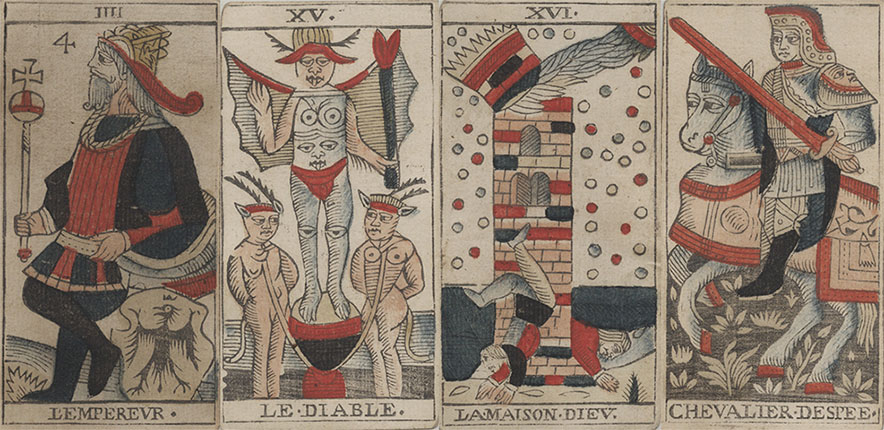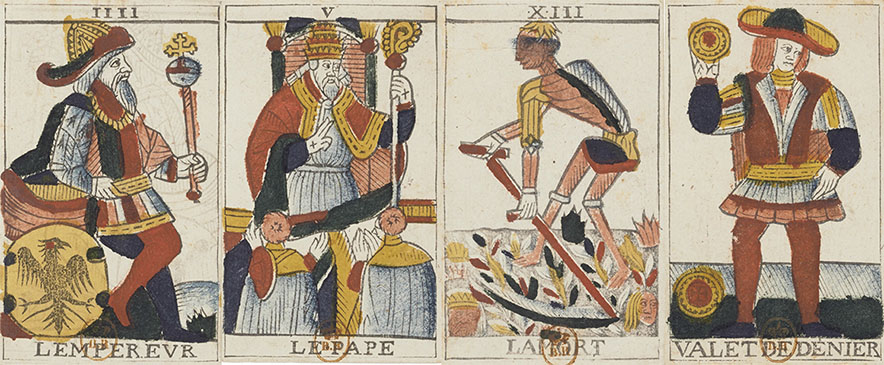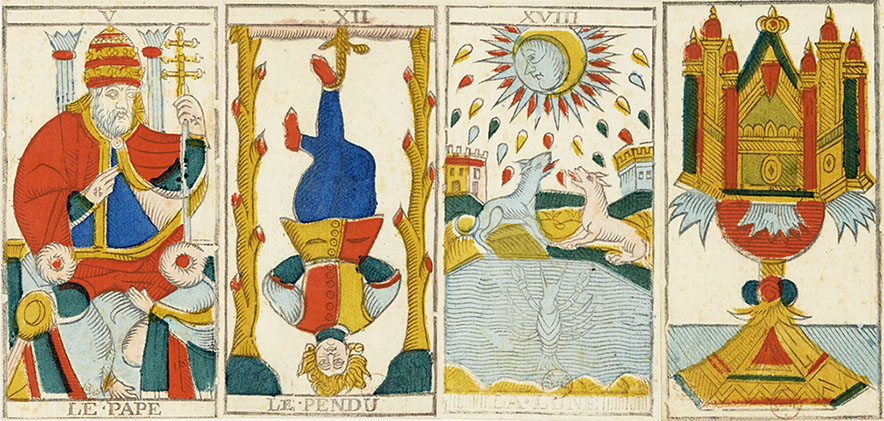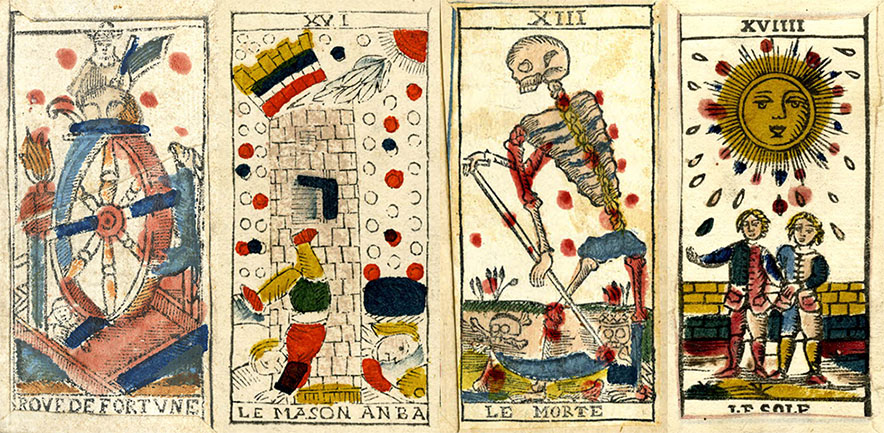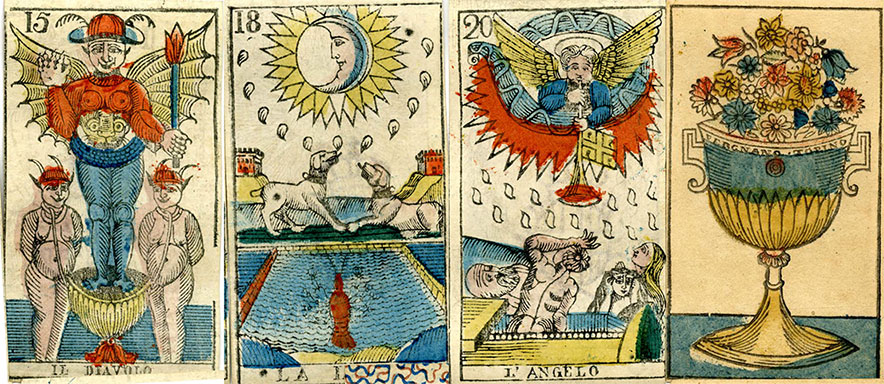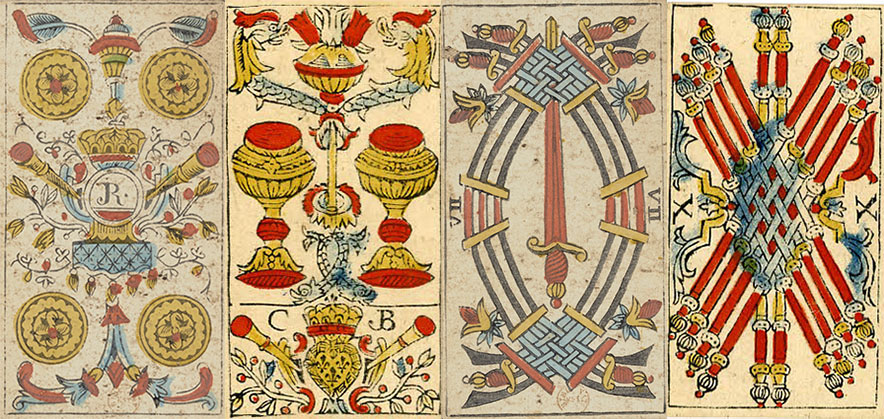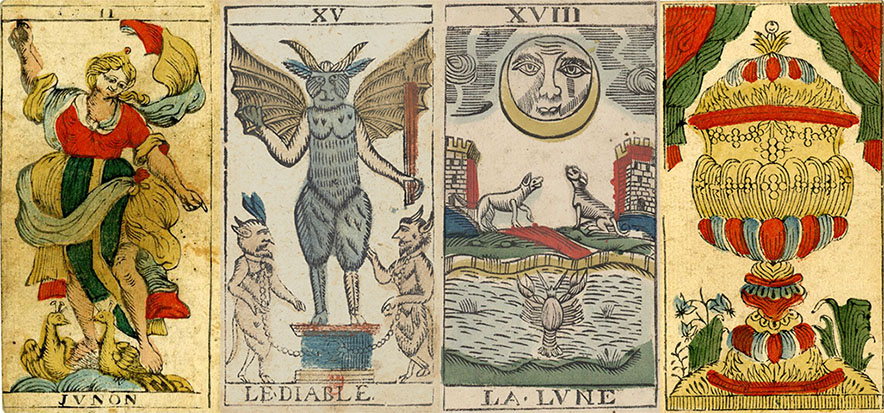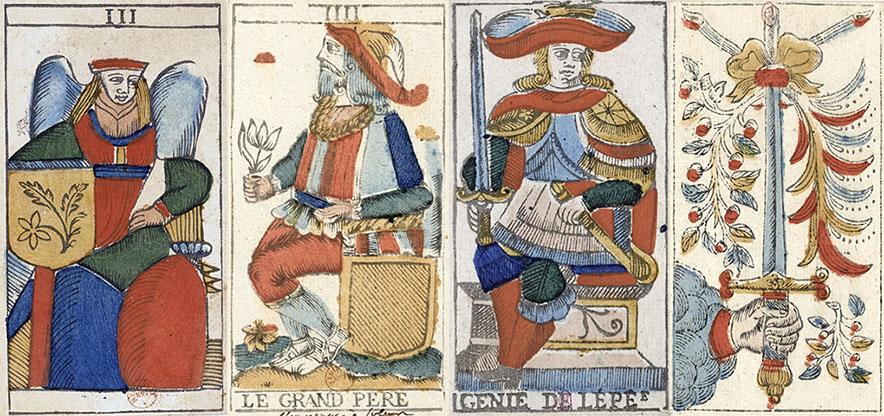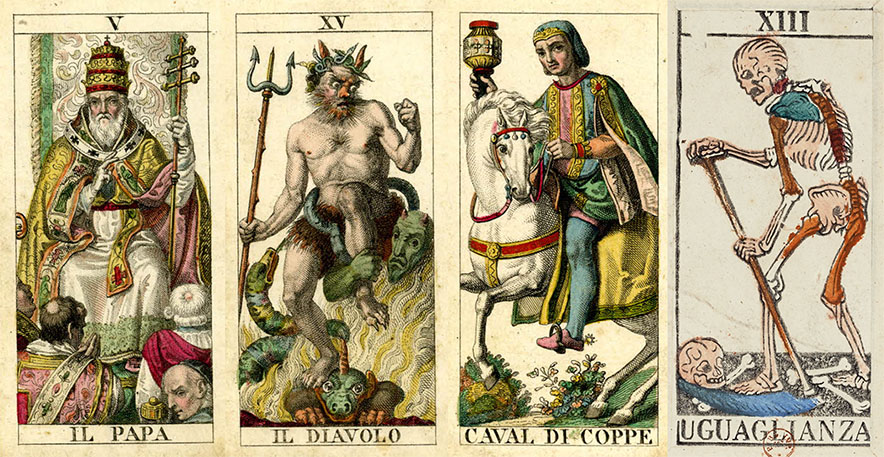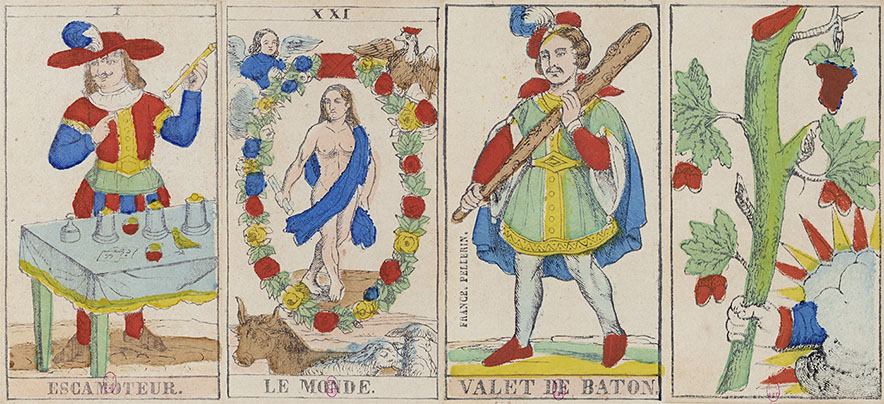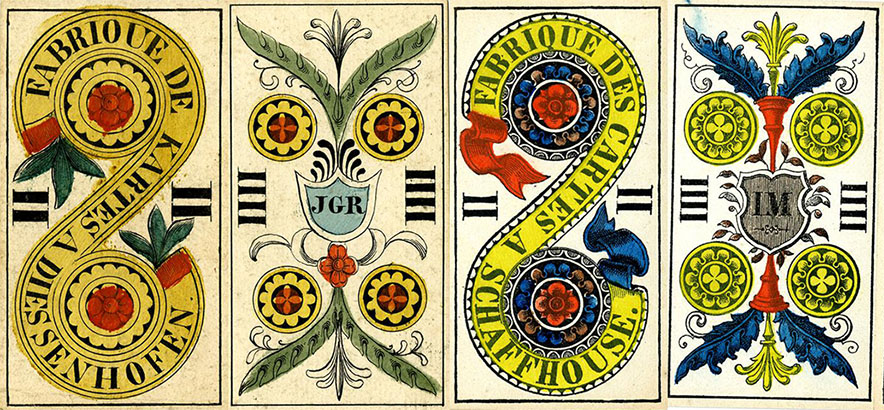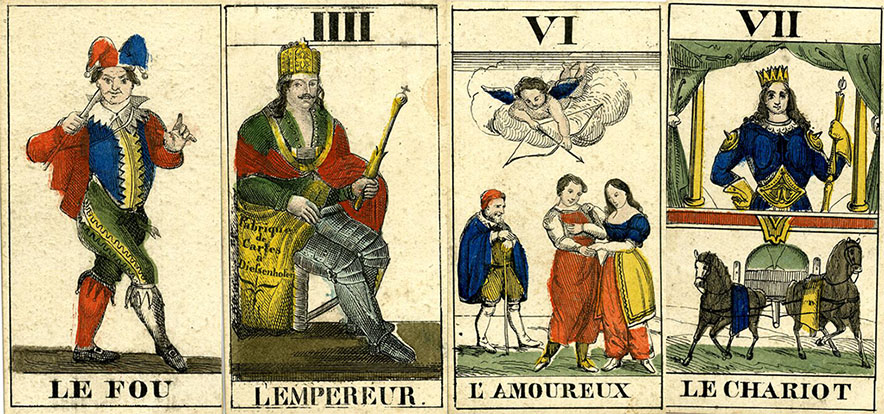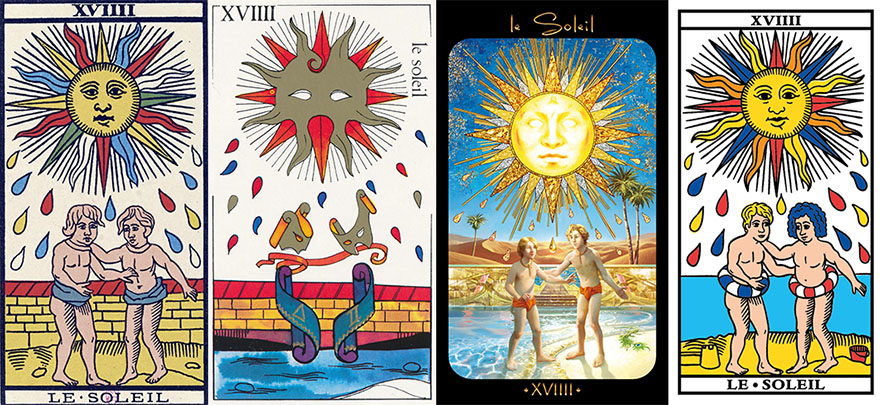THE TAROT WHEEL
THE DIFFERENT TDM RELATED STYLE GROUPS
In the past, only two TdM style groups were recognized, called type I and type II TdM decks. Recognizing that these are the main TdM styles, I think it is useful to categorize the different style groups that developed from the TdM decks. Including the original TdM styles, there are at least 12 different style groups, sometimes used by one single card factory, sometimes used on a much wider scale:
- Type I TdM decks - Oldest TdM style, probably originating in Milan. In France, the members of the Lyonese printers guild, used exclusively this style.
- Type 0 TdM decks - Only one deck is known, the Tarot of Jean Noblet, the oldest-known deck that can call itself a TdM deck. It is probably inspired by the same Italian source as the type I decks, without copying exactly the cards.
- Type II TdM decks - This became the most popular TdM style. The oldest-known deck is made by Pierre Madenié in Dijon, and the most popular one is the 19th Century deck of Nicolas Conver, realized in Marseille.
- French titled Tarocco decks, produced all over North Italy until the early 19th Century.
- Tarot of Piemont, a style group that developed in the Italian Piemont area, but that was also popular in the French Savoie region and around Nice
- Swiss made TdM decks, that were considered as standard TdM decks, but with some local peculiarities
- Tarot of Besançon, also called Swiss Tarot, is a style group that has its origins in Northeastern France, but that was also widely produced in Germany and Switzerland.
- Tarot of Besançon decks modified by the French Revolution. This is not a real style group, but special enough to be mentioned
- Italian titled Tarocco decks, that were especially popular in the region around Milano
- Tarot of Epinal, a variant of the Besançon Tarot, developed around 1830 by the French Epinal based Pellerin card factory.
- 1JJ Tarot decks, another variant of the Besançon Tarot, created in 1831 by Johann Georg Rauch and printed in his card factory in Diessenhofen. He sold this factory in 1838 to Johannes Müller, whose progeny moved the factory to Schaffhouse, and is still producing these cards through AG Müller. In association with US Games Systems, this deck is also commercialized on the American market.
- Modern TdM decks - a revival of the TdM decks, that started with the Ancient Tarot de Marseille, published in 1930 by Grimaud.
It is impossible to show for each of these 12 style groups all differences, I will try to show for each group four of the most characteristic cards.
Type I TdM decks
The type I TdM decks are probably the closest to the original imagery of their Italian ancestors. In the page about the three generations of TdM decks, we saw already some characteristic of the type I decks, differentiating them from the type II decks. These were the name Le Fol for the Fool, the blindfolded Cupid flying to the left on the Lovers card, the typical form of the Sun rays and the male figure on the World card. Here above we use the deck of Jean-Pierre Payen, dated to 1713, to show some other typical characteristics of these decks. On the card of the Emperor, we see a number 4 in front of the emperor's head. This number is probably the signature for the Lyonese printer's guild, whose members produced mainly type I Tarot decks. The Devil has a second face on its stomach and eyes on its knees, not existing on type II cards. The Tower is exploding, the flames are directed upwards to the sun, in contrary to type II decks, where the flames are directed from the sun to the tower. The Knight of each suit is called Chevalier, on type II decks this will become Cavalier.
Type 0 TdM decks
The only known representative is the deck of Jean Noblet, who based the imagery of his deck, probably, on the same Italian decks as the type I cards. So, his deck inherits many of the characteristics of the type I decks, but not all of them. Some features of this deck are very specific and differentiates this deck immediately from both type I and type II decks. On the page about the three generations of TdM decks we saw already on the card the Fool its name, Le Fou, and the fact that he is showing his genitals. Here above some other typical features of this deck, justifying why I place it in a separate category, the Emperor who is facing to the right, the shepherd crook in the hands of the Pope, Death is named and facing to the left and the name of the Page of Coins that is appearing in a text box on the bottom of the card, on all other decks this is written on the right side of the card.
Type II TdM decks
The TdM type II decks are a luxury version of the original type I decks. To achieve this, most images have been redesigned. The form did not change a lot, but the drawings were carved with greater care, and they are showing more details. The cards shown here above are from the Nicolas Conver deck, probably the most well-known TdM deck and effectively printed in Marseille. Nicolas Conver started printing this deck in 1809. However, he re-used existing woodblocks that were carved in 1760 by an unknown card maker. Some differences with the older decks not yet mentioned are the Pope's staff surmounted by a triple cross, a Hanged Man that is much more serene than on the older cards, and a Moon looking to the left instead of facing us. A feature the three pure TdM decks have in common is the Ace of Cups, where we find on the cup some sort of walled city, much like the New Jerusalem on the World card of the 15th Century Visconti Sforza deck.
French titled Tarocco decks
If one thing can be said about the French titled Tarocco cards, it is that they don't adhere strictly to the TdM pattern. The Tarocco decks do not copy exactly a single model, nor do they copy exactly each other. However, they have some things in common. Because the Tarocco decks are not identical, I show here cards coming from four different decks, to illustrate some of their common characteristics.
The first card on the left is from a deck made by Francesco Berti in Bologna. It is dated to the 17th Century, but it inherits features from both type I and type II TdM decks. This might sound strange because this deck is older than the oldest-known French type II TdM deck. The card we show here is the Wheel of Fortune. On the French TdM decks, we see on the left side a monkey descending the wheel. The tail of the monkey has been transformed in a flame, and its head became the head of en independent figure below the wheel. This same deformation of the original wheel can be observed on almost all Italian Tarocco cards.
The second card has been made in 1744 by a card maker called Giachomo Chastelano who was working in Serravalle, a small town situated between Genoa and Milano. The engraver who carved this deck did not master French at all, so La Maison Dieu became Le Mason Anba. Even on the French TdM decks, we can see a lot of spelling mistakes, but definitely not as much as made by many Italian card makers.
The third card is from an 18th Century deck produced by an anonymous card maker in Gorizia, a town in the Northeastern part of Italy. This is a nice example of a card that follows the main theme, but he changes many details. The skeleton is terrifying with his lower jaw that disappeared. Look at the differences with the card of Jean Noblet, earlier on this page. The heads that Death is harvesting on TdM decks, become here skeletons themselves. The French word La Mort is written Le Morte, in Italian it should be Il Morte, so it becomes a mix of both languages.
The fourth card is from a deck produced in 1790 by Angelo Valla in Trieste. Here, Le Soleil loses its last two characters to become Le Sole. In Italian, this is written as Il Sole. On this Sun card, we see two very well-dressed boys, also a feature we find on many Tarocco decks, in contrast with the almost naked children on the TdM decks.
Tarot of Piemont
The actual Piemont area is the Northwestern part of Italy, with Torino as capital. Originally, the Duchy of Savoie also included the Savoy region in France, some Southwestern parts of Switzerland and the territory around Nice. In the 14th and 15th Century, the French town of Chambéry was the capital, but this was transferred in 1563 to Torino, There are written testimonies that there was a card production in the 16th Century, but no cards survive, so we don't have a lot of information about these cards. Apparently, during the 17th Century, only TdM decks imported from France were in use. Card production started again only around 1735, with clones of the TdM decks, but relatively independent of decks elsewhere in Italy. At the beginning of the 19th Century, the card makers tried to regionalize the decks with Italian titles and slightly modified images. On the previous page, we saw the card of the Fool, where the jumping animal is replaced by a butterfly. The decks mix both type I and II characteristics while adding some local touch. Here above some images from the Torino-based card maker Vergnano from a deck he made around 1830. The Devil lost the genitals shown on the TdM decks, and the type I face on his stomach is clearly the head of a cat. The Moon is typical for type II decks, but the crawfish is now placed in an artificial basin. The Judgement card is now called L'Angelo (the Angel). The Ace of Cups lost the New Jerusalem on top, and became a bowl full of flowers.
Swiss made TdM decks
At the beginning of the 18th Century, the TdM decks started to disappear in France as a game. The production that stayed in France was made almost exclusively for export purposes. The center of the TdM industry moved across the border to Switzerland. In the first half of the 18th Century, Switzerland produced perfect TdM decks, like the decks made by François Heri in 1718 and 1730. Around the middle of the 18th Century, the Swiss-made TdM decks got some very distinctive features, characteristic for all TdM decks made in Switzerland. On the previous page we saw the very joyful Sun card, characteristic for Swiss made decks. Other differences are visible in the pip cards. Here above some examples from two different decks, a deck produced by Gassmann in 1850 in Genève (the first and the third card), and a deck produced one century earlier, in 1751, by Claude Burdel in Fribourg (the other two cards). On the 4 of Coins, we see two trumpets (or whatever it is) coming out of the center of the card. On the 2 of Cups, these trumpets appear again at the bottom of the card. When using the French TdM decks, the Swords and Batons are often confused because they both have blades on top and on the bottom. On the Swiss made cards, the Swords have real handles on one side and blades on the other side. Concerning the Swiss-made batons, the blades disappear, and we now have real scepters.
Tarot of Besançon
In the same period that the TdM production faded away in France, a new variant was born in Northeastern (German speaking) France that became rapidly popular in neighboring Germany and Switzerland. In this variant, the Pope and the Popess were replaced by Jupiter and Junon. The decks had also some other features that differentiated them clearly from the standard TdM decks. On the previous page, we have seen two typical Tarot of Besançon cards, the card where Jupiter is replacing the Pope and the Sun card, with its very typical wall behind the two children. Here above four other cards that show some of the features that are shared by most Besançon decks. The first card is published in 1746 by François Laudier in Strasbourg (France), the city where probably the first Besançon decks were printed. On the card we see Junon, who is replacing the Popess, accompanied by two peacocks. The second example is printed in 1784 by Bernard Schaer in Soloturn, Switzerland. Here we see a modest Devil, with his genitals now invisible. The third card is from a deck published in 1810 by Renaut in Besançon, who used woodblocks made by Jacob Jerger. The Moon sickle is pointing upwards, and the face of the moon is looking straight into our eyes. The last card ha been printed somewhere in the 18th Century by Joseph Krebs in Fribourg-en-Brisgau, Germany. It shows the Ace of Cups in a form used by all Besançon decks (plus by some other Swiss made decks).
Tarot of Besançon decks modified under influence of the French Revolution
In 1789 began the French Revolution, resulting in 1793 in the execution of the French King. This was the beginning of a new era, that started a new calendar, weeks of 10 days, decimal time and many other measures that changed profoundly the French society. One of the victims was the TdM style decks, from 1793 to 1799, in France, it was only allowed to print modified Besançon decks, where all references to religion and royalty were removed. This manifested itself in two ways. Some card makers just wiped out all royal and religious symbols and names. The first card, representing the Empress, is an example of this type. The deck has been printed in 1794 by Guillaume Mann in Colmar. All crowns and lily flowers have been wiped out, as well as the names on many cards. The virtue of Justice becomes Lady Justice in adding a blindfold over her eyes. A second approach is to wipe out, or to change, all religious and royal symbols, and to change, where necessary, the names of the cards. The second card is published in 1794 by J. Benoist in Strasbourg. He uses woodblocks carved in around 1750 by François Isnard. The card shown her is the Emperor, who becomes Le Grand Père (the Grandfather). The Empress becomes La Grande Mère (the Grandmother), the Hermit becomes Le Peauvre (the Poor) and the Last Judgement is baptized into La Trompète (the Trumpet). La Maison Dieu (the God House) did not change from name because it is not related to religion. La Maison Dieu was the name for a place where poor and/or sick people could find a place to rest, to eat and if necessary some health care. The next two cards are corrected in 1793 by Louis Carey, using woodblocks, also engraved around 1750 by François Isnard. On this card, we see the King of Swords, where the word Roy is replaced by Genie (Spirit). the Page on these decks change from Valet to Egalité (Equality) and the Queens change from Reyne to Liberté (Liberty). Only the Knight does not change its name, the French word Cavalier being the equivalent of Horseman. The last card, the Ace of Swords, is one of the many examples, where a Crown has been replaced by something else.
Italian titled Tarocco decks
At the beginning of the 19th Century, card playing and making were still regional businesses. The Piemont region had its Tarocco Piemontese, around Bologna Tarocchino (Tarocco Bolognese) was the most popular game, Florence had its Minchiate game, etc. There were many regional games, and the cards were made by regional card makers. In Bologna, the production of the French titled Tarocco decks came to an end in this period, they did not make the step to Italian titled Tarocco decks. However, in the region around Milano happened something that would boost the card making industry. In 1809, the German printer Fernando Gumppenberg, member of an old Bavarian noble family, emigrated to Milano, where he introduced new printing techniques. These new techniques gave the local artists huge freedom in designing new decks. One of these artists was Carlo della Rocca, whose Soprafino deck was published in 1835 by Gumppenberg. Based on the TdM model, he created a beautiful and detailed version of the Tarocco with Italian titles. Only for the Devil card he did not use the TdM as a model, but the corresponding card of the Bolognese Tarocchino deck created by Giuseppe Mitelli around 1665-1668. Here above three examples of these stunning cards, the Pope, the Devil and the Knight of Cups. Other North-Italian card makers, like Edoardo Dotti and the Avondo brothers, created during the 19th century decks based on the Soprafino model. Some other card makers continued to produce Tarocco decks based on the TdM model, and printed with the old woodblock technique, but using Italian titles instead of the French ones. One of them was Teodoro Dotti. The last card here above is from a deck he published in 1860 in Milan. The card shown above is trump number 13 that is usually printed without a name. Dotti called the card Uguaglianza, that can be translated as Equality.
Tarot of Epinal
The Tarot of Epinal is a variant of the Tarot of Besançon, published for the first time in 1830 by the card factory Pellerin in Epinal. While respecting the Besançon model, in detail it had some distinctive features. The first one is that Pellerin did not use woodblocks, but an improved printing technique, allowing him, just as the Milanese Gumppenberg printing press did, to print much more detailed drawings. However, contrary to Gumppenberg, Pellerin still stenciled the colors on the cards. Here above four cards showing some specific features of this deck. The first card on the left is called Escamoteur. An escamoteur is someone who makes things disappear. On the table, we see three cups upside down. Under one of the cups is an object, like a coin, a die, or anything else. He shows under which cup he hides the object, he changes places of the cups and asks the audience to point where this object is. Of course, the audience has it almost always wrong. Another card that changed his name was the Hermit, that became a Le Capucin, indicating the Capuchin order of monks. Further, he changed many other details on the trump cards. As an example, the World card, where he replaced the lion by two sheep. Other examples of trump cards he changed are Justice and the Chariot. The court cards also became modernized, and some figures on the cards had their position changed. As an example, I show here, as the third card, the Page of Batons, that is usually facing to the right, with his club posed on the ground. The last card shows that even the pip cards were not spared. The Ace of Batons is now a living branch, full of leaves and acorns. A bunch of grapes is attached to the highest branching of the club.
The Tarot of Epinal was printed by Pellerin until 1860. In modern times, several card publishers have a copy of this deck in their assortment.
The 1JJ Tarot
In 1831 Johann Georg Rauch, card maker in Diessenhofen in Switzerland, developed a new variant of the Tarot of Besançon. It was called the 1JJ Tarot. JJ stands for Jupiter and Junon replacing the Pope and the Posess in the TdM decks, and the number 1 indicates that it is the first version. In 1838; he sold his factory to Johanes Müller, who continued printing the decks in Diessenhofen until approximately 1860, when he created a new factory in Schaffhouse, a nearby town. Here he developed a second version of this deck, still commercialized under the name of 1JJ Tarot. The decks are signed on the 2 and 4 of Coins, so they are easy to distinguish. Here above on the left side the 2 and 4 of Coins of the original deck and on right side the 2 and 4 of Coins of the second version. On the 2 of Coins is marked the town where the cards are printed (Diessenhofen and Schaffhouse) and on the 4 of Coins the card maker (JGR = Johann Georg Rauch and IM = Johanes Müller).
How did the 1JJ Tarot distinguish itself from the original Besançon Tarot? Here below four cards to illustrate the differences:
The cards presented here above are all from the original Diessenhofen, deck, but the later Schaffhouse/AGMüller decks show the same features. The first card on the left is the very characteristic Fool card of the 1JJ deck, that looks like a Joker of any standard card game. In fact, the 1JJ decks were, and still are, decks made for game playing. In the Southeastern part of Switzerland, where this game is the most popular, they call it the game of Troccas. This game-playing aspect is also clearly visible in the other trumps, where we have a huge leading box displaying the card number. The second card shows the Emperor. Except for the name of the card, all references to the Holy Roman Empire have disappeared, and the card is now used to indicate where the deck has been printed. On the third card, the Lovers, we see a young couple in love. Cupid is now heading his arrow of love to the young girl, contrary to the TdM decks where he is aiming the boy. The third person is not giving advice anymore to the couple, it is just an old man, looking from a certain distance, remembering his own youth. On the last card, we see the Chariot. The scene is now divided in two parts. On the upper half we see the victorious prince, and on the lower half we see two horses pulling a chariot.
Modern TdM decks
The first card on the left, here above, is from the 1930 edition of the Tarot de Marseille, published by the card factory Grimaud. In 1930, the master card maker and collector Paul Marteau, owner of the Grimaud card factory, that was created by his grand-uncle Baptiste-Paul Grimaud, published a deck he called Ancien Tarot de Marseille. This deck became extremely popular and was at the base of the revival of the interest in the Tarot de Marseille. Before this date, most Tarot decks belonged to the Tarot de Besançon family, or they were a copy of the Etteilla decks. For this reason, we can consider the Ancien Tarot de Marseille as the father of the modern Tarot de Marseille decks. To end this page about the different style groups of the Tarot de Marseille, I want to present the Sun card, the most positive card of the tarot, of several modern decks. Most modern decks are, like the deck of Grimaud, reproductions or recreations of old Tarot de Marseille decks. I have chosen to present some decks that follow definitely the Marseille tradition, but where the artists give a very personal interpretation of these cards. Without surprise, all these artists are French.
The second card has been published in 1982 by Alain Bocher (http://alain.bocher.free.fr/Le%20Tarot%20de%20la%20Rea.htm). The deck is called Tarot de la Rea, and it consists of a very strange collection of floating silhouettes and masks, covered with gold and silver ink. It is an exceptional deck, and anyone used to work with the TdM, will instantly recognize all figures, be it a trump card or a court card.
The third deck has been imagined by the tarologist Emmanuelle Patrigeon and realized by the artist Soufiane Mengad (http://www.tarotland.com/monTarot.php?section=tarot). The deck is called Mon Tarot de Marseille, and it has been published by TarotLand since 2012. It is a very modern deck with vibrant colors. Thanks to its 3D presentation, the deck seems to be alive, with real persons that could step any moment out of the cards.
The last deck is a very recent project from the artist Julien Labat. This deck started as an art project in 2020. Stimulated by the success of his exposition, he created the Tarot de Sète (https://www.tarotdesete.fr/). The individual cards can be admired on his personal site (http://julienlabat.fr/tarot-de-sete-jeu). The art project was the result of Julien's fascination of the Tarot de Marseille and of his love for Sète, an important port city just South of Montpellier, not far from Marseille. Sete has 12 km (7.5 miles) of beaches on the Mediterranean coast, so most cards have a drawing situated on a beach.
And here ends the summary for the different style groups of the Tarot de Marseille. If there are any errors, if I forgot a specific style, or if you have other comments, don't hesitate to contact me.
